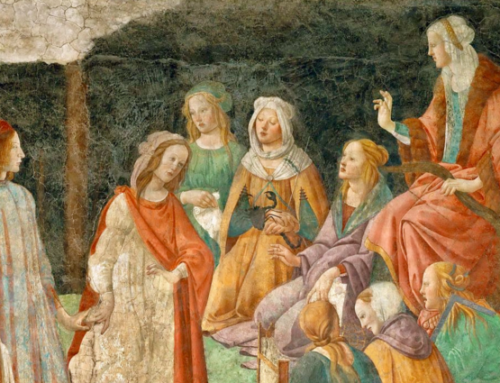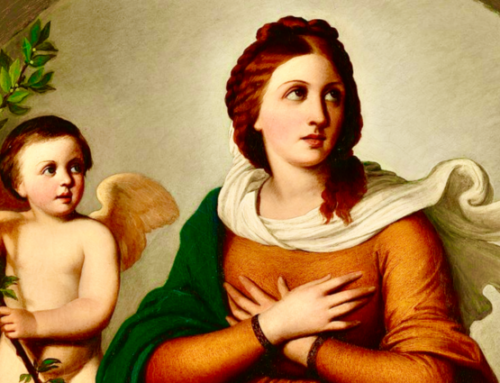Chivalrous and self-effacing in a completely genuine and unconscious way, Thomas Howard was a bona fide gentleman, in the old-fashioned sense of the word. He was a walking witness of all that is good and gracious in life, serving as a tacit reminder of goodness, truth, and beauty.
When Thomas Howard died in October last year, at the venerable age of eighty-five, I was asked by the editor of Catholic World Report to write a personal memoir of him. Although I had intended to do so, I never got around to it until such time as I felt that other people had already said what I would have written. Now, however, having just revisited one of his books, I feel ready to take up the pen.
Thomas Howard was a bona fide gentleman, in the old-fashioned sense of the word. He was chivalrous to the very core of his being and self-effacing in a completely genuine and unconscious way. He spoke in archaisms that made it appear that he had stepped out of a time-machine, or a wardrobe, from a different age and place; and, it must be said, from a much better age and place. He was a walking witness of all that is good and gracious in life, serving, therefore, as a tacit reminder of all that’s been lost in our culture’s abandonment of the goodness, truth, and beauty that breathes life into life itself.
He wrote relatively little in the final years of his life, which means that he is much less known than he ought to be. Perhaps he is best known for his book, Evangelical is Not Enough, in which he offers the reasons for his conversion to Catholicism. He was, however, a literary critic of the first order, writing books on the fiction of C.S. Lewis and Charles Williams and, most especially, Dove Descending, a literary and spiritual meditation on T.S. Eliot’s Four Quartets, which I was honoured to bring to publication when I was editor-in-chief of Sapientia Press.
As worthy of attention and praise as these works are, Thomas Howard’s most important book is probably Chance or the Dance? which, as its subtitle proclaims, is “a critique of modern secularism.” Having recently had the enormous pleasure of discussing this book for several weeks with Father Fessio and Vivian Dudro of Ignatius Press for the FORMED Book Club, it reminded me of Thomas Howard’s gentle and genteel genius. Take, for instance, his polite corrective to the way that many of us view the imaginative faculty:
It is common enough for us to think of imagination as something for the poets, or, if it has anything to do with us, as brought into play only in our reveries when we dream of flying away to some fruited island in a tropical sea. But it is more than that. It is something that is at work in us every moment of our lives, sleeping and waking, and that shapes every thought we have about ourselves or anything else.
Imagination was “the faculty by which we organize the content of our experience into some form, and thus apprehend it as significant.” It is the refusal to see experience as “mere random clutter” and the means by which such experience is shaped into manageable form. The imaginative faculty enables us “to reach across a gulf that cannot be spanned… by the analytic faculty in us.” It brings things together rather than breaking them apart. It synthesizes rather than analyses. It is the “tendency… from the abstract toward the concrete, and not vice versa.” This tendency of the imagination contrasts with the scientific method which dismantles the thing under scrutiny to discover the truth.
Thomas Howard’s genius does not reside, however, in his ability to grapple with philosophical definitions but in his ability to incarnate or concretize abstractions into living analogies. He shows us that the human imagination manifests itself in every aspect of our daily lives in ways that transcend and supersede the limitations of the scientific method. We have “festooned everything” with symbolic actions and gestures. “We shake hands,” he says, which is “pure ceremony.” Such commonplace rituals, done unthinkingly, nonetheless “bespeak much more than can be discerned in the functional demands of the situation itself.” They signify “our awareness that things are worth something—that they are significant.”
Howard’s privileging of the imagination and the way that it concretizes the abstract into the daily symbolic rituals of life is rooted in a cosmology that sees reality as a divinely ordered dance and not as merely random chance. He labels these two approaches to reality the old myth and the new, seeing the difference between the two perspectives as quite literally abysmal, in the sense that an abyss separates them. The abyss is the difference between meaning and its absence, between something and nothing, between Creation ex nihilo and merely nihilo. It is the abyss that separates the void from the avoidance of the void. This is how he summarizes the significance of the ordered understanding of the “old myth,” the Dance:
The system that was articulated in that original creative event was ordered (God or the gods at the top, and the rest of us—archangels, men, clams—ranged down the ladder), significant (things meant something; the common stuff of experience signaled something that was true all up and down the ladder), and teleological (that is, purposive: the ladder went somewhere).
This cosmological order of significance and purpose, in which things meant something and went somewhere had been replaced by Nothing. No order, only chaotic chance; no significance, only meaninglessness; no purpose, only futility. It was the replacement of homo viator, man on a quest or a pilgrimage, with John Lennon’s Nowhere Man, living in his nowhere land, making all his nowhere plans for nobody.
Seeing Andy Warhol’s “soup cans” as emblematic of the spiritlessness of the age, Howard spoke of “an iconography of ennui and disgust and anguish.” Nowhere Man, bored, disgusted and angst-ridden, has nowhere to go except to the somewhere that really exists. All that he needs to do is leave the lonely basement of his own ego and accept the invitation to the Dance.
As for Thomas Howard, whose Chance or the Dance? is itself an invitation to the Dance, we can be sure that he is now treading a measure, a galliard no doubt, to the Music of the Spheres in the presence of the love that moves the sun and the other stars.
The Imaginative Conservative applies the principle of appreciation to the discussion of culture and politics—we approach dialogue with magnanimity rather than with mere civility. Will you help us remain a refreshing oasis in the increasingly contentious arena of modern discourse? Please consider donating now.
The featured image is courtesy of Ignatius Press.








Thomas Howard was my father’s Chaplain’s assistant in the 1950s, the only place in the Army that afforded him an opportunity to transcend the militarism of this vocation. He was not only gracious and kind to a short, patched-eye nerd, he was funny. Throughout his contact with us, he demonstrated both the breadth of Christian learning and the comedy of the Christian faith. He blessed us all.
Excellent! I’ll have to get that book.
Wonderful article, and since one of my goals in the time I have left is to begin to gain an understanding of Eliot’s Four Quartets, I will be looking forward to reading Dove Descending.